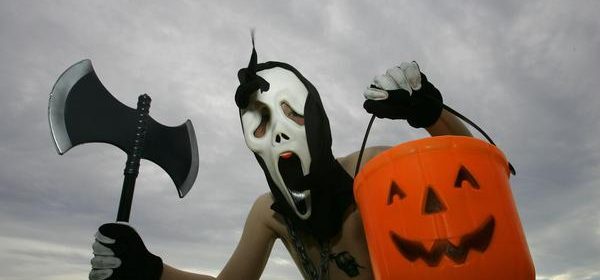How to stay safe while trick-or-treating on Halloween during the pandemic

Goblins, ghosts and witches will haunt the streets of Denver in just over a week as children trick-or-treat once again after the coronavirus pandemic stymied much of the traditional Halloween activity last year.
Trick-or-treating carries a low risk of exposure to the virus, if it occurs outdoors, although public health experts caution that those who venture out on Halloween should still take precautions to further reduce the chances of getting COVID-19.
“Being outdoors, the risks are relatively low,” said Alex Huffman, an aerosol scientist at the University of Denver, adding, “If you want to be as safe as possible, what I would do, is have a little bit extra distance as you walk around.”
Halloween traditions were upended last year due to the pandemic, but this year the U.S. Centers for Disease Control and Prevention has approved the door-to-door activity, with director Dr. Rochelle Walensky saying last month, “We should be able to let our kids go trick-or-treating in small groups.”
Transmission of the coronavirus in Colorado has increased in recent months, notably among children and teens. But the trajectory of the pandemic is murky. New cases appeared to fall last week, while COVID-19 hospitalizations increased to their highest point this year.
“We know going into the winter months and people going indoors more, we expect (cases) may continue to increase,” said Jini Puma, an associate professor at the Colorado School of Public Health.
Public health and aerosol experts offered guidance on trick-or-treating during the pandemic.
Outside activities are safer than indoors
Trick-or-treating is considered a low-risk activity because it primarily occurs outdoors. Indoor activities, such as parties, should be avoided because they increase the risk of the virus spreading, according to public health officials.
The state health department recommends people gather outside for Halloween, including by hosting neighborhood costume parades or going to open-air haunted forests or corn mazes.
For gatherings indoors, the agency advices people to improve ventilation by opening windows, doors or running their heat, air conditioning or an air purifier, according to the Halloween guidance issued by the Colorado Department of Public Health and Environment.
“As with everything else, outdoor risk is substantially lower than indoor risk because the air people breath out dilutes so quickly outside,” Huffman said.
He is planning to take his three children — all under 12 years old — trick-or-treating this year.
“I feel much more comfortable this year than I did last year,” Huffman said, adding that more is now known about how the virus spreads through the air.
One area to be aware of is the doorway, which can get crowded with children seeking treats. On a cold night, hot air from inside can rush outside into the crowd of trick-or-treaters gathered at the door, potentially carrying infectious aerosols, he said.
Wearing a mask can add further protection in this scenario, Huffman said.
Other precautions to take while trick-or-treating
Public health experts recommend having children wear cloth or surgical masks with their Halloween costumes. However, the state health agency said, costume masks should not replace cloth or surgical masks as they will not prevent the spread of the coronavirus.
“Wear COVID-19 protective masks when indoors or if you are not fully vaccinated,” the state health department recommends.
Masks are especially recommended for children under 12 who cannot yet get vaccinated. Those who are eligible to get immunized should do so to help protect young children, according to the agency.
Another way to reduce the risk while trick-or-treating is to stay in small groups with close family and friends. The virus is less likely to spread via candy, but children should still wash their hands before eating their treats, Puma said.
Source: Read Full Article